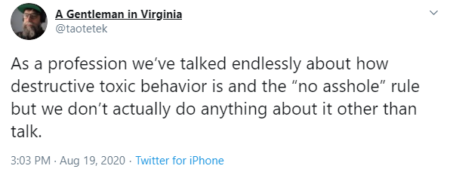The “No A–hole” Rule: Addressing Toxic Behaviour in the Workplace

Some of us follow celebrities and famous brands on social media to get a glimpse of their day-to-day life and culture – just so there’s something we could look up to and fantasize about. But as I was reading through this article exposing the truth behind popular luggage brand Away’s toxic work environment, it became clear that what we see on the small screens of our devices is not a full picture of reality.
Knowing the Consequences
Poor job satisfaction, increased turnover, damaged brand image… the side effects of a toxic work environment should be enough to put you back on the right track. In this day and age, don’t underestimate the power of word-of-mouth. The convenience of the internet and social media makes it easy for anyone to vent their problems online. A single tweet, or in this case of Away – a 4,500-word article published on The Verge – was all it needed to leave a scar on the well-recognized brand.
It’s a bit scary to think that all the actions you take as a company are being discreetly monitored by your employees, your customers, or the general public. But this is exactly the reason why business owners must take careful steps before endorsing their so-called “fun and embracing” work culture. Knowing how quickly things can spread, you don’t want to go viral for the wrong reasons.
Actions Speak Louder

It should be common sense to know that bullying, discrimination, micromanaging, and all sorts of unfair practices are wrong and destructive. Yet in reality, people fear speaking up about them because doing so can threaten the relationship they have with their boss, or worse – cause them to lose their job. The weight, therefore, shifts to HR to ensure that people are treated fairly at work. But even with such authority over the workplace, there are times when HR professionals may have their hands tied for the sake of protecting the company from negative media attention or even a lawsuit. So here we are, back to ground zero.
While there are benefits of having protocols around to keep these matters in control, a healthy work culture can’t be forged under a list of regulations set by HR alone. How you behave collectively as a member of your organization matters:
- If you’re the boss… lead with empathy and compassion. A good example set by a leader can make all the difference.
- If you’re the manager… be equal and fair. Create a safe and open team environment where everyone gets a chance to show their full potential.
- If you’re a coworker… act as an ally. Though you may have the least direct influence, stand up for your peers and give them the kind of support they need the most.
As we’ve mentioned time and time again, a good corporate culture involves more than just attractive perks and amenities. It doesn’t matter if you’re a multi-billion dollar company or a startup-sized firm, the “no asshole” rule applies to everyone of any rank.